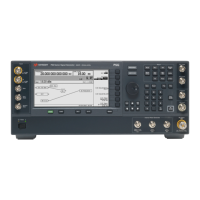336 Keysight Signal Generators Programming Guide
Creating and Downloading User–Data Files
User File Data (Bit/Binary) Downloads (E4438C and E8267D)
10–byte file header to a bit file. When the signal generator uses this file, it will recognize only
131 of the 136 bits (17 bytes) contained in the file.
For information on downloading block data, see “Downloading User Files” on page 332.
Commands for Binary File Downloads
To download a user file as a binary file type means that the signal generator, when the file is
selected for use, sees all of the data contained within the file. For more information on binary files,
see “Binary File Type Data” on page 327. There are two ways to download the file: to be able to extract
the file or not. Each method uses a different SCPI command, which is shown in Table 6-8.
File Name Syntax
There are three ways to format the file name, which must also include the file path:
• "BIN:file_name"
• "file_name@BIN"
• "/user/BIN/file_name"
Command Syntax Example
The following command downloads a file that contains 34 bytes:
:MEM:DATA "BIN:new_file",#2347^%S!4&07#8g*Y9@7.?:*Ru[+@y3#_^,>l
Table 6-8 Binary File Type Commands
Command
Type
Command Syntax
For
Extraction
SCPI :MEMory:DATA:UNPRotected "bin:file_name",<datablock>
This downloads the file to the signal generator. You can extract the file within the
context of a program.
FTP
a
a
See “FTP Procedures” on page 339.
put <file_name> /user/bin/file_name
No
extraction
:MEM:DATA "bin:file_name",<block data>
This downloads the file to the signal generator. You cannot extract the file.
Query :MEM:DATA? "bin:file_name"
This returns information on the named file: <bit_count>,<block_data>.
Within the context of a program, this query extracts the user file, provided it was
download with the proper command.
Query :MEM:CAT:BIN?
This lists all of the files in the bit file directory and shows the remaining
non–volatile memory:
<bytes used by bit files>,<available non-volatile memory>,<"file_names">

